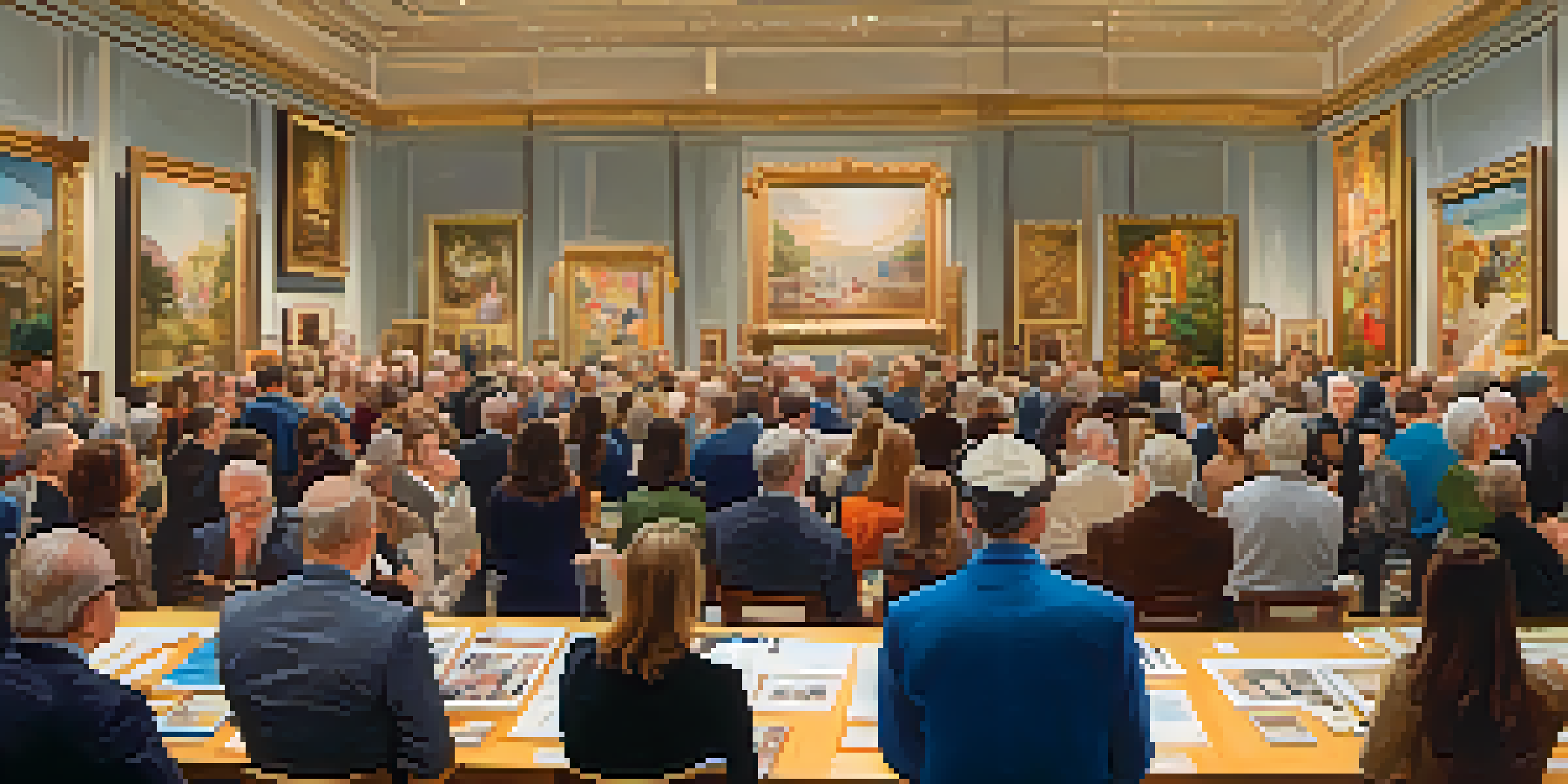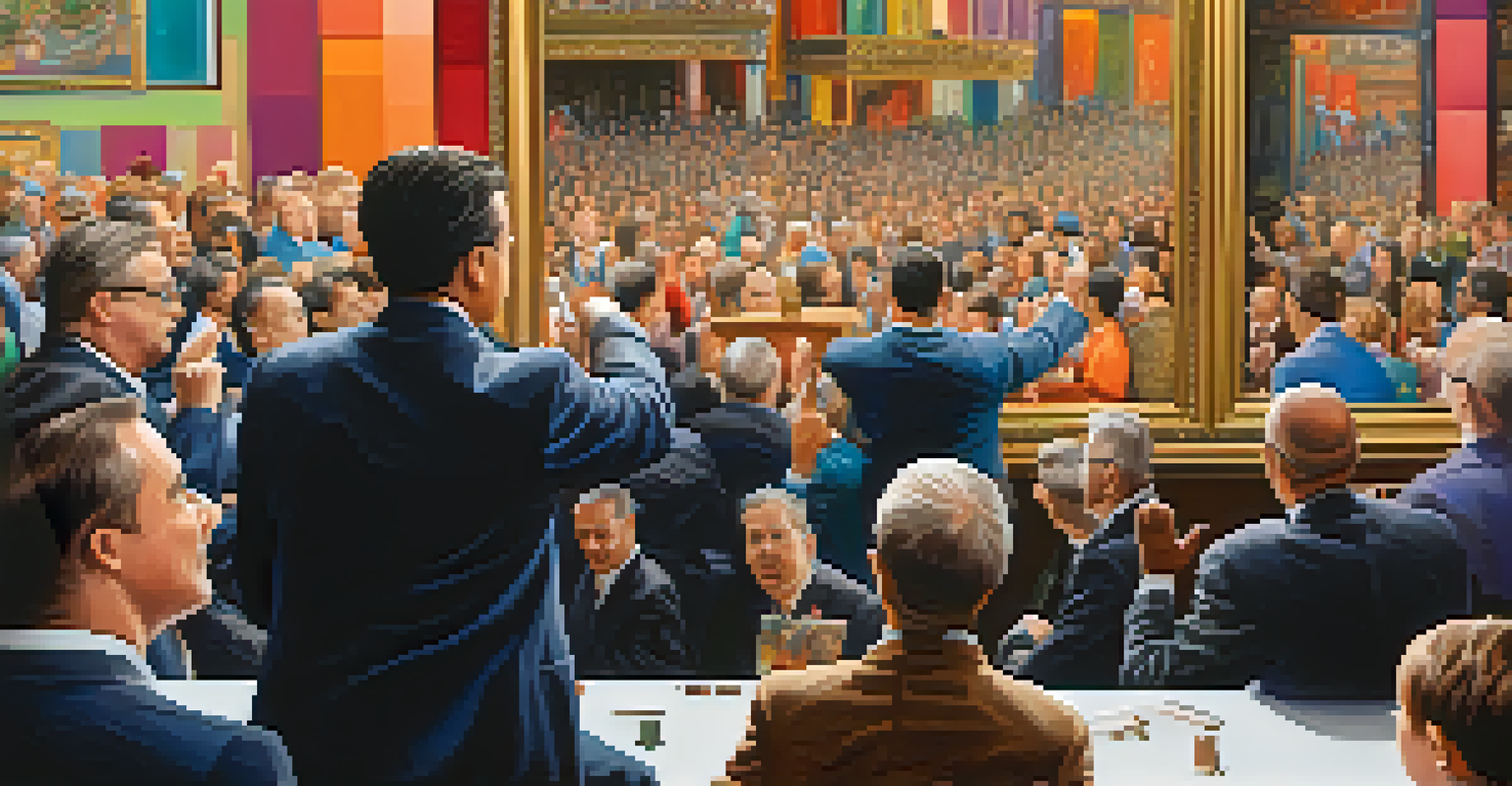Art Auctions: How They Work and Their Economic Impact

What Are Art Auctions and How Do They Work?
Art auctions are events where artworks are sold to the highest bidder. They can take place in person at galleries or auction houses, as well as online through specialized platforms. Bidders compete against each other, showcasing their desire to acquire unique pieces, while auctioneers facilitate the process.
Art is not what you see, but what you make others see.
Typically, an auction begins with a preview period, allowing potential buyers to examine the artworks closely. This is followed by the auction itself, where the auctioneer introduces each piece and manages the bidding process. Bidders raise their paddles or click buttons, signaling their offers until the highest bid is reached.
Once the bidding concludes, the winning bidder pays the hammer price, which is the final bid amount. Additionally, buyers often need to pay a buyer's premium, which is a percentage added to the hammer price. This structure creates a dynamic environment where art enthusiasts can acquire coveted pieces.
Types of Art Auctions: Live, Online, and Hybrid
Art auctions can be broadly categorized into live, online, and hybrid formats. Live auctions are traditional events held at physical locations, creating an energetic atmosphere where bidders can interact directly. These are often accompanied by expert commentary, enhancing the experience.

Online auctions have surged in popularity due to their convenience and accessibility. Bidders can participate from anywhere in the world, placing their bids at any time within the auction window. This format allows for a wider audience, increasing competition and potential sale prices.
Art Auctions: Bidding Dynamics
Art auctions are competitive events where artworks are sold to the highest bidder, facilitated by auctioneers in various formats.
Hybrid auctions combine both live and online elements, offering the best of both worlds. Participants can bid in person while also allowing online bidders to join in real-time. This flexibility caters to different preferences and can significantly expand the bidding pool.
The Role of Auction Houses in the Art Market
Auction houses serve as vital intermediaries in the art market, connecting sellers with potential buyers. They provide expertise in valuing artworks, ensuring that pieces are appropriately appraised before being offered for auction. This valuation process is crucial for setting realistic expectations for both sellers and buyers.
The best artist has no conception that a marble block does not contain within it the sculpture, but rather that it is a sculpture waiting to be revealed.
In addition to facilitating sales, auction houses often play a role in marketing the artwork. They promote upcoming auctions through various channels, including social media and email newsletters, reaching a broader audience. Their reputation can significantly influence buyer confidence and interest.
Furthermore, auction houses have access to extensive databases of past sales, helping them gauge market trends. This information not only aids in pricing but also gives insight into the evolving tastes of collectors and investors, shaping the future of art auctions.
Factors Influencing Art Auction Prices
Several factors contribute to the final price of artworks at auction. The artist's reputation is paramount; well-known artists typically command higher prices due to demand and perceived value. Emerging artists may attract interest, but their works usually sell for less until they gain recognition.
The condition and provenance of an artwork also significantly impact its price. A piece with a documented history and in excellent condition is more likely to fetch a higher bid. Bidders are often more willing to invest in artworks that come with a verified background.
Impact of Auction Houses
Auction houses play a vital role in the art market by valuing artworks, marketing them, and connecting sellers with buyers.
Market trends and economic conditions can shift bidding behavior as well. During economic downturns, luxury items like art may see less interest, while a booming economy can lead to increased competition and higher prices. Understanding these dynamics is key for both buyers and sellers.
The Economic Impact of Art Auctions
Art auctions contribute significantly to the economy by generating revenue for auction houses and artists alike. The sale of high-value artworks can lead to substantial commissions for auction houses, which often reinvest in marketing and expanding their services. This cycle helps sustain the art market.
Moreover, successful auctions can raise the profile of artists, leading to increased demand for their work. This not only benefits the artists financially but also stimulates the broader art ecosystem, including galleries and museums that showcase their pieces.
Additionally, art auctions can attract tourism, particularly in cities renowned for their art scenes. High-profile auctions often draw collectors and enthusiasts from around the world, benefiting local economies through spending on hotels, dining, and cultural experiences.
Challenges Faced by Art Auctions
Despite their significance, art auctions face various challenges that can affect their success. One major issue is the authenticity of artworks; forgeries can undermine buyer confidence and lead to legal disputes. Auction houses must take strict measures to verify the authenticity of pieces before they are sold.
Market volatility can also pose risks for auction houses and sellers. Economic fluctuations can lead to unpredictable bidding behavior, making it difficult to forecast prices accurately. Sellers may find themselves in a position where their pieces do not sell for expected amounts, leading to potential losses.
Digital Revolution in Auctions
The rise of digital platforms is transforming art auctions, enhancing accessibility and integrating innovative technologies for a broader audience.
Lastly, the increasing prevalence of online auctions means that traditional auction houses must adapt to changing consumer preferences. They must invest in technology and develop strategies to remain competitive, ensuring that they can continue to attract bidders in a rapidly evolving landscape.
The Future of Art Auctions in a Digital Age
As technology continues to evolve, the future of art auctions is increasingly intertwined with digital platforms. Online auctions have already transformed how buyers and sellers interact, and this trend is likely to continue. Enhanced virtual experiences, such as 3D previews, are becoming more common.
Additionally, the rise of blockchain technology promises to enhance transparency and security in the art market. By providing a secure record of ownership and provenance, blockchain could mitigate concerns over authenticity and fraud, making auctions more appealing to buyers.

Ultimately, the convergence of traditional auction methods and innovative digital solutions is likely to shape the future landscape of art auctions. This evolution will not only enhance accessibility but also broaden the reach of art to a more diverse audience, ensuring its relevance in a changing world.